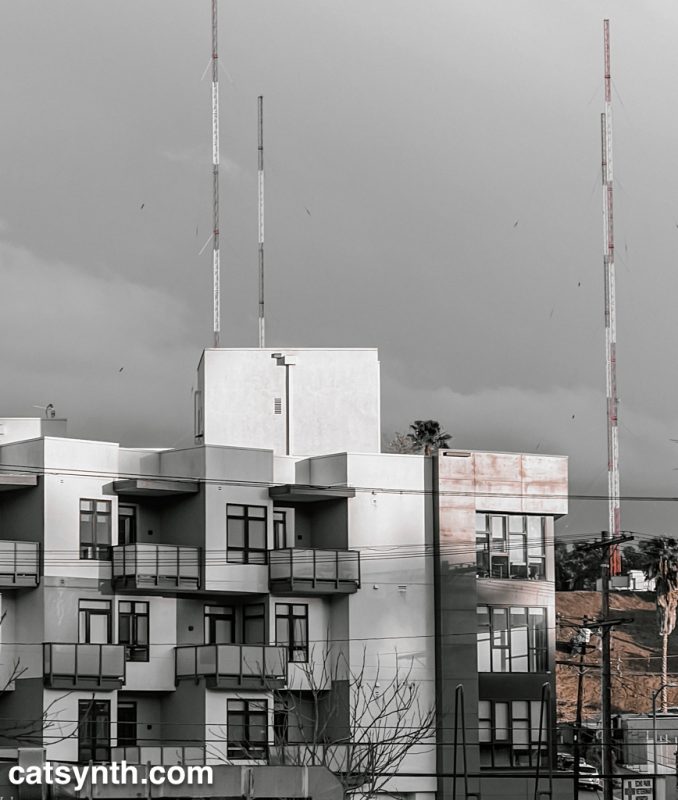
los angeles
Weekend Cat Blogging with Sam Sam: Sheltering from #CaliforniaFires
California is on fire. To our south, the area northwest of Los Angeles that I remember fondly from past visits in on fire, including Malibu and Thousand Oaks. To our north, the devastating Camp Fire has laid waste to much of the town of Paradise, is threatening Chico, and is among the smokiest I have ever experienced. If anything the air quality in San Francisco is even worse than it was during last year’s wine-country fires, which were much closer.
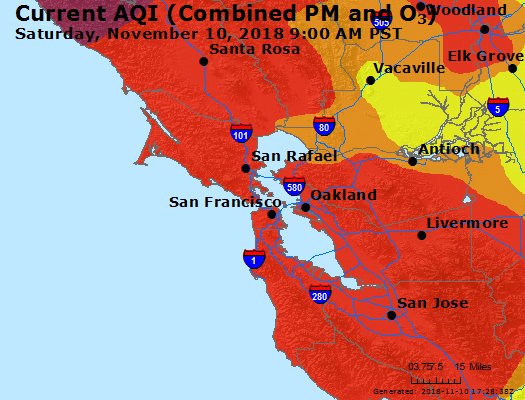
We’re mostly hiding indoors during this time, at least as much as we can. Even just opening the patio door for a minute left my eyes watering and nose as if I was just breathing straight out of a charcoal grill. Yesterday, Sam Sam seemed quite distressed as the particulates seeped into HQ (mostly from the main hallway). Today is slightly better, and she is more like her normal goofy self, including showing off her
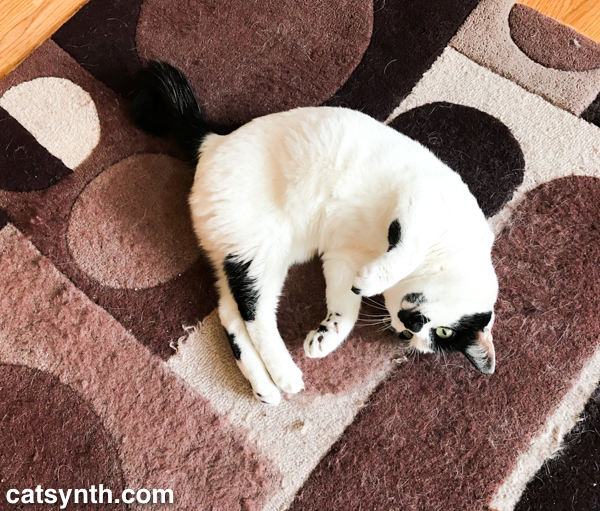
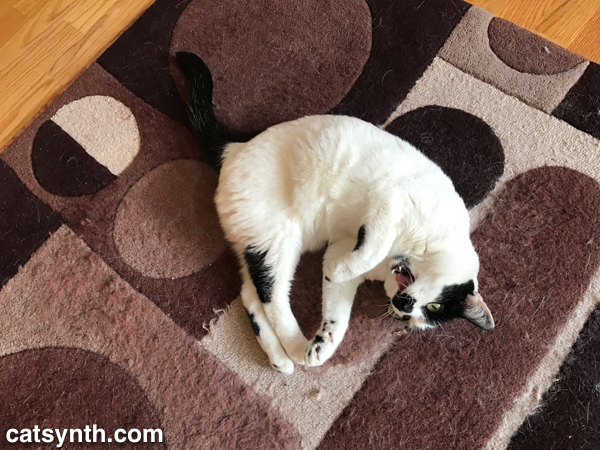
But she still is finding places to hide – if I can smell the smoke, I can only imagine it’s much more intense for her. Yesterday, before I left for work, she jumped up on my chest and snuggled in, wanting me to stay and be close. I had to go, but came home as soon as I could after my in-office responsibilities were done.
We do also worry about our pal Marlon in Oakland, who spends much of his time outside.
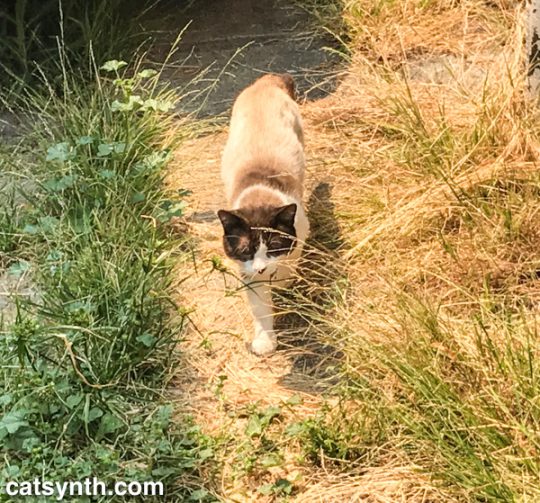
The light from the smoky skies is stunningly beautiful. It’s amazing how such beauty can arise from something as awful as this.
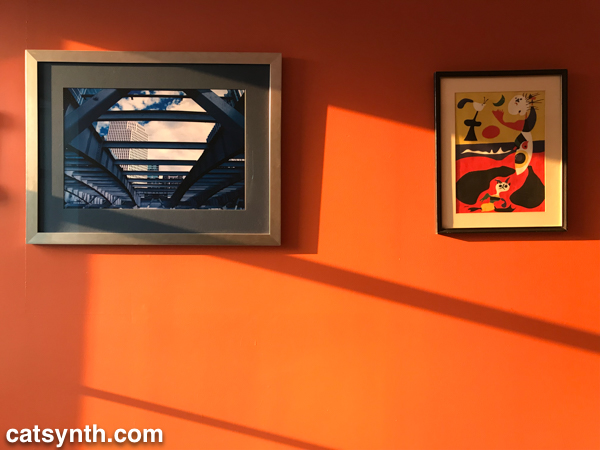
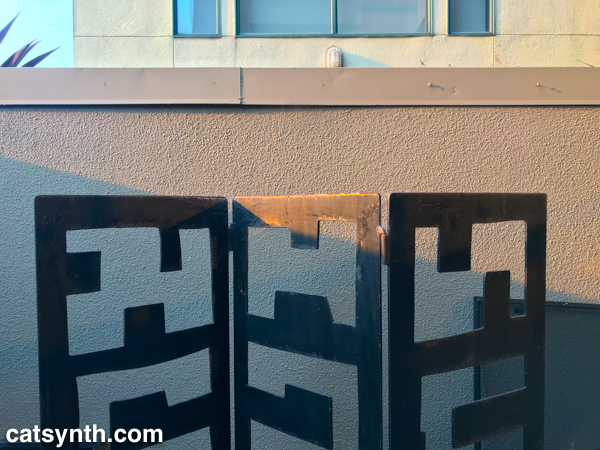
But in all, we need to put our challenges in perspective. I can’t imagine the horror and pain people in the fire zones are going through, losing their homes, fearing for their loved ones, and of course their companion animals. The messages I see from people searching for their missing cats, or the heartbreak of not being able to rush home to rescue them, is painful and our hearts go out to them. Other animals, too, of course, as we hear about horses, dogs, and birds.
Both north and south zones have evacuation shelters for those who have small or large animals. In the north, Butte County has set up a line for those who either find and are searching for lost pets in coordination with North Valley Animal Disaster Group.
NVADG is active both in trying to locate and rescue lost pets, as well as running multiple shelters for those with animals. From their website:
NVADG is providing emergency animal sheltering and where and when allowed will evacuate and/or care for animals in evacuation areas.
Animal shelters will be established at:
Small Animal Shelter: 2279 Del Oro Avenue, Oroville. Off Nelson near the County Center and Highway 70.Small Animal Shelter 150 Airpark Dr, Chico at the Chico Airport
Large Animals should be taken to the Rolling Hills Casino Equestrian Center off Highway 5 in CorningIf you want to donate to NVADG, please consider a cash donation. It gives us the flexibility we need and we will definitely need it! Donate on our website or send a check to NVADG, PO Box 441, Chico, CA 95927.
We certainly hope all the fires around our home state are brought under control soon, and the air returns to normal as well. Then the hard work of rebuilding begins…
California Highways 47 and 103, and the Ports of Los Angeles and Long Beach
At the southern edge of Los Angeles County lies the Ports of Los Angeles and Long Beach, the two largest and busiest in the United States. They are in some ways an entire separate city, with their own network of bridges and freeways beyond the regular network of Los Angeles and its environs.
 We begin our exploration in a quiet and somewhat industrial section of Long Beach along Willow Road. Seemingly in the middle of nowhere, we encounter the northern California Highway 103, the Terminal Island Freeway which is a major truck route to the port. It might be the heavy truck traffic that accounts for its being in rather poor shape.
We begin our exploration in a quiet and somewhat industrial section of Long Beach along Willow Road. Seemingly in the middle of nowhere, we encounter the northern California Highway 103, the Terminal Island Freeway which is a major truck route to the port. It might be the heavy truck traffic that accounts for its being in rather poor shape.

 Heading south on CA 103, we pass through a flat, industrial landscape. It is a bit desolate, but beautiful in its way. There are only two interchanges, one of which is with CA 1. Continuing past the interchanges, the freeway transitions to California Highway 47 and crosses the Cerritos Channel to Terminal Island the ports on the Commodore Schuyler F. Heim Bridge. This is a massive lift bridge that can accommodate large ships accessing the port.
Heading south on CA 103, we pass through a flat, industrial landscape. It is a bit desolate, but beautiful in its way. There are only two interchanges, one of which is with CA 1. Continuing past the interchanges, the freeway transitions to California Highway 47 and crosses the Cerritos Channel to Terminal Island the ports on the Commodore Schuyler F. Heim Bridge. This is a massive lift bridge that can accommodate large ships accessing the port.

It has an old industrial and dystopian feel to its architecture, particularly on the foggy morning when I visited. Since then, the bridge has been decommissioned and is in the process of being replaced.

I left the freeway at New Dock Street to get a closer look and to take more photos of the bridge and other details of the ports. Photographing around the working port has its challenges with a great many areas fenced off, and a no doubt a heightened suspicion of odd people wandering around with cameras. I did get a few, some of which are shared here. They have also appeared in Wordless Wednesday posts (and will continue to do so).


CA 47 turns onto the Seaside Freeway runs east-west and bisects Terminal Island. Heading east, the freeway (also known as Ocean Boulevard) the graceful Gerald Desmond Bridge, becoming I-710 heading north through Long Beach.

You can read about our separate adventure along I-710 is this article.
Following CA 47 west along the freeway, one winds up and down between elevated and surface sections before ascending to the photogenic Vincent Thomas Bridge.


There is a small park on the west side of the bridge, which affords one a change to get out, walk, and view both the bridge and the channel. There are families and others here, many probably from the adjacent community of San Pedro. We have in an instant left the industrial landscape of the port and entered the residential landscape of greater Los Angeles. It is appropriate the CA 47 ends here and the freeway turns north as I-110, the Harbor Freeway. But that is a story for another time.
Wordless Wednesday: Through the Yellow Glass
LACMA: Levitated Mass, Frank Gehry, Diana Thater
At the end of my trip to NAMM, I always try to leave time for a museum visit in Los Angeles, more often than not to LACMA. This is a somewhat belated review of this year’s visit.
Since seeing the film on the Levitated Mass, it was an absolute priority to experience the giant sculpture by Michael Heizner in person. For those unfamiliar, it is a 340-ton boulder mounted above a concrete trench. The space underneath is open and thus viewers can walk under the boulder.

It is an impressive feat of engineering (as documented in minute detail in the film), and a visually interesting conceptual piece. It is definitely one has to experience in person to understand.

One of the main special exhibitions at LACMA in January was a retrospective on the work of Frank Gehry. While none of his actual buildings were on display (though it would have been appropriate in the context of Levitated Mass), there were many drawings and models, group into conceptual and chronological phases of his career.

Many of his most famous pieces, such as Disney Hall and Guggenheim Bilbao, were on display. But also large lesser-known buildings an smaller designs, some of which were never built. In the photo above, we see a building that combines the undulating organic structures for which Gehry is famous with a more traditionally modernist linear outer structure. The model in front is quite different, and more geometric and colorful that one sees in his iconic works.
It is also fun to see the small structures and private homes. I am envious of those who could have a Gehry-designed home like this one.

By sheer coincidence, Frank Gehry was present that afternoon to give a talk and Q&A session. I managed to get into the overflow audience to catch part of it.

The wide-ranging discussion including a bit of his personal history, his interest in biology and particularly in fish, and his disdain for computer modeling – he agreed that it was an amazing tool, but not for visually understanding a piece of architecture. On the topic of fish, they reviewed a few purely sculptural pieces of his that were meant to represent the swimming motion of a single fish or an entire school. Though he perhaps his voice sounded a bit gruff – something which bothers me not at all – he was very much engaged with the questioners and supportive.
In the modern pavilion, it did stop to see a few familiar large installations. I enjoy walking inside of this large-scale Richard Serra sculpture and find it quite meditative. It was also interesting to contemplate its curving structure in terms of what I had just seen and heard from Frank Gehry.

From the curving structure I then moved on to straight lines. This familiar light installation reflects onto the window facing Wilshire Blvd and makes for great self-portraits.

I also had a bit of fun with self portraiture in the retrospective exhibition for Diana Thater, which featured several room-sized pieces with multiple projections of moving images.

Though that was fun, the piece itself was dead serious, looking at the aftermath of war through ruined buildings.

There were some pieces in the exhibition that were less dark, as in Butterflies that features both lights and video bathed in red ambient lighting.

[Diana Thater, Untitled Videowall (Butterflies), 2008. Six video monitors, player, one fluorescent light fixture, and Lee filters . Installation Photograph, Diana Thater: The Sympathetic Imagination, Los Angeles County Museum of Art. © Diana Thater]
One doesn’t always know what to expect on a on-afternoon trip whose date is not timed to a particular exhibit, but I am never disappointed with what I encounter at LACMA, and that was true again this year.
Wordless Wednesday: Century and Harbor Freeway Interchange, Los Angeles
Wordless Wednesday: Downtown LA
Quick takes: MAS attack LAxSF and Surrey Street Salon
It’s been a while since I have reported on one of those evenings with multiple cultural events that enrich life here. One recent rainy evening involved a visual art opening and a salon with a variety of performances.
I started at 17th Street Studios in the Mission for MAS Attack: LAxSF, a one-night show that featured 30 artists from Los Angeles and San Francisco, respectively.
One of the particularly intriguing pieces in the show was Miri Chais’ Rabbit Hole, with its organic circular forms but technology-inspired details and changing blue patterns of light. The mixture is intentional, and the title is inspired by Alice in Wonderland.

Utopian Heads by L.A. artist Mark Dutcher caught my attention for its evoking of painting styles and concepts of the early twentieth century experiments. The title of the piece seems to fit with that as well.

It seemed that the artists from L.A. dominated my attention at the show. As with the above pieces and the one below by Steven Wilkoff, they seemed to unapologetically modern.

But these piece from Oakland-based artist Scott Greenwalt did provide a contemporary take on abstraction.

It was then off to Glen Park, just a short trip south from the Mission along the miniature freeway known as San Jose Avenue. (But that’s a story for another time.) My destination was the Surrey Street Salon for a fun evening of performance with a circus theme. So of course there were clowns with vaudeville-style musical numbers.

There was also serious musical talent on display. I was quite impressed with Tin Sandwich, an all harmonica band.

Their instruments ranged from tiny inch-long specimens to the large bass harmonica.

Their arrangements, while mostly traditional songs, were quite tight, and included some impressive solos. I would definitely want to see them again.
Surplus-1980 bandmate Moe! Staiano also performed, this time on solo percussion.

His avant-garde percussion playing is frenetic, moving quickly from on idea and one instrument to another, whether it is part of his traditional drumset or superballs against the window.
In all, it was a great evening of music and art, and the two events provided quite a contrast in style.
Wordless Wednesday: 9391 (Water Tower)
I-710 and the Los Angeles River
After the intensity and non-stop stimulus of NAMM, I try to reserve the final Sunday for solitude and exploration of the greater Los Angeles Area. My most recent post-NAMM exploration included a trip north on I-710.

 Officially the “Long Beach Freeway”, the highway runs alongside the Los Angeles River for much of its length. The Los Angeles River is a naturally flowing river, but it has been encased in a concrete channel. It’s a rather dystopian vision, but very much characteristic of 20th century LA. It has served as a setting for numerous movies – think the scene in Terminator 2 where the cars crash in a giant concrete ditch and the shapeshifting guy walks away. Of course, I had to photograph this monument myself as well. I joined I-710 at its interchange with Highway 91. The river immediately comes into view to the right, concrete channel and all. However, along this section there has been a lot of work to provide green space on the banks, with bike and walking paths connecting a series of parks. I left the freeway at the Imperial Highway exit for a closer look.
Officially the “Long Beach Freeway”, the highway runs alongside the Los Angeles River for much of its length. The Los Angeles River is a naturally flowing river, but it has been encased in a concrete channel. It’s a rather dystopian vision, but very much characteristic of 20th century LA. It has served as a setting for numerous movies – think the scene in Terminator 2 where the cars crash in a giant concrete ditch and the shapeshifting guy walks away. Of course, I had to photograph this monument myself as well. I joined I-710 at its interchange with Highway 91. The river immediately comes into view to the right, concrete channel and all. However, along this section there has been a lot of work to provide green space on the banks, with bike and walking paths connecting a series of parks. I left the freeway at the Imperial Highway exit for a closer look.

[The mighty Los Angeles River.]
This location is actually the confluence of two rivers. The San Gabriel River, also enclosed in a concrete channel for much of its length, flows into the larger Los Angeles River – the merging of the two concrete channels is unique.

[The San Gabriel and Los Angeles Rivers.]
I suppose I choose to see the beauty in scenes like these where others refuse to or can’t. But on another level, it is not entirely a choice. I am inexorably drawn to such things. Even as are attitudes towards development change from 20th century models, I’d like to see artifacts like this concrete river preserved.

North of the Imperial Highway, I-710 crosses the Los Angeles River to the east bank.

[I-710 crossing the Los Angeles River.]
The freeway begins to diverge from the river, heading due north towards Pasadena and controversial “dead end”. You can read more about the efforts to complete (or not complete) the highway at the California Highways website. However, I chose to leave the highway and follow the river instead.
A stretch of Bandini Boulevard grazes the river, affording views of a section that is unequivocally industrial. No parks or bike paths here. But even here I can find visual beauty in the bleakness of the scene.

The river is of course in no way devoid of life. Tenacious vegetation can be found along the channel, and there are plenty of birds who take advantage of the shallow water.

I continued north near to the river into the city of Los Angeles. The industrial character remained for a while, and reminded me a bit of the southeastern section of San Francisco that I often frequent, but on a grander scale. I didn’t stop here, but perhaps I should have. Towards downtown, the river becomes incorporated into the greater city, with classic art-deco bridges spanning the channel. I crossed it one last time on the First Street Bridge:

[By Downtowngal (Own work) [CC-BY-SA-3.0], via Wikimedia Commons]
It was early enough to still visit a couple of L.A.’s art museums, but I am glad I was able to spend time first with this piece of the city’s history, and a work of art in its own right.




